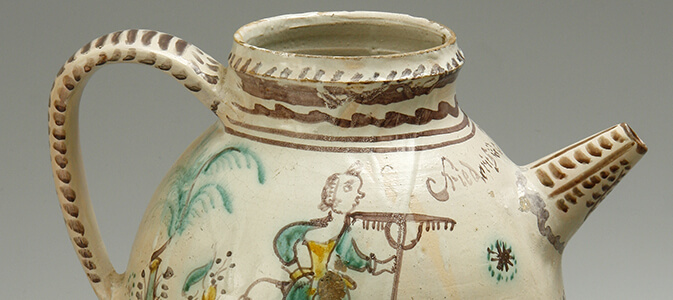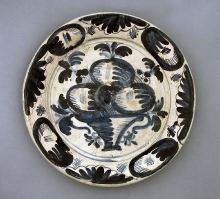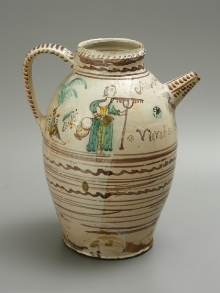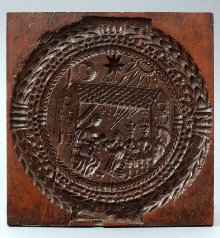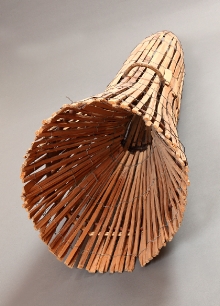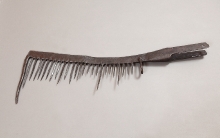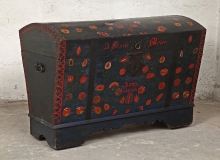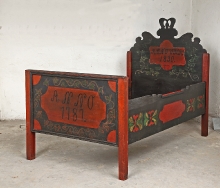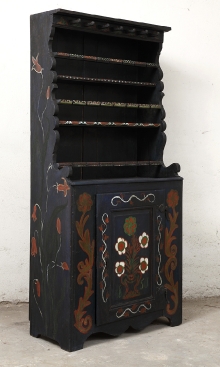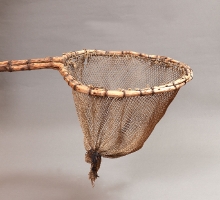The Department of Ethnography of Pomerania was created in 1983, however collecting ethnographical relics began in 1945. At that time several objects (ca. 600) taken over from German museums, mainly Landesmuseum in Szczecin, were put into the collection. Cultural and ethnic transitions, that Western Pomerania underwent especially in the 20th century, are visible in multi-regional character of the collection. Presently, it amounts to over 7 thousand exhibits. They include relics illustrating German folk culture of Pomerania, objects from various regions of Poland within its boundaries from before the second world war, brought by migrants and settlers after 1945 and objects made in our times.
The leading collections include: objects related to fishing and agriculture, craftworks, (among others, blacksmithery tools, weaving tools, plaited wares, furniture, ceramics, glass), fabrics and elements of folk costumes, folk artworks, traditional Pomeranian ceremonial and everyday use objects.
Collections related to individual boat fishing and maritime character of the region are represented by numerous kinds of tools and equipment, such as multi-tooth fishbones, fishing spikes, combs, anchors, fishing traps, nets,anchors, floats, scoops, as well, as 15 fishing boats, including, typical for the area of lower Oder and Szczecin Lagoon: Warpno-type boat, Stołczyn-type boat and lake fishing boat, as well, as seagoing boat. The precious collection includes a group of 13 sailing trapezoid-shaped trunks from the 19th century. On the interior sides of the lids of several of them there are the owners’ names and decorations of their design.
Folk craftworks are represented by both tools and products. A large collection are blacksmithing objects: bellows, anvils, pincers, pliers, hammers and horseshoes, shears, padlocks, supports, weathervanes, artistic forged locks, hinges and metal fitting. Among plaiting wares „kószki” - straw hives popular in Pomerania deserve attention.
Rich collection are tools tools for processing wool and fibre. Among them there are rich-ornamented spinning devices and boxes made of bound wood, which were not used for work, but were fiance’s wedding gift for the bride.
In the collection of ceramics and glass, particular attention should be paid to dishes of pale colours with lead-tin cover, blue-green ornamented with plant, animal or architectural motives, being examples of White ceramics characteristic for Western Pomerania in 18th and 19th centuries, known as Stettiner Ware.
Unigque, interesting object is a bottle with a bearded man's face. These glassware used for wine, popular among seamen in 17th and 18th centuries, originated from so called Bartman's school of Frechen. In rich collection of folk furniture of the period from the end of the 17th to the first half of the 20th century there are distinctive trunks, wardrobes and dressers usually flower-ornamented with a tulip as the leitmotif.
Settlers and migrants arriving in Pomerania after the second world war brought, most of all, household tools and everyday use objects. Furniture were scarce among their possessions. One of those not numerous objects is a precious Lemko huche trunk of archaic construction.
The collection of fabrics consists of, among others, objects brought from Podlachia, Eastern Borderlands and South-Eastern Poland. Artistry characterizes double, so called Vilnius fabrics, and, weaved with multiple heddles, towels or cross-stitch ornamented shirts.
Precious relics among elements of folk clothings – mainly Pomeranian, but also from outside it – are parts of women's costume from Pyrzyce: a scarf, a glove, a sock and a handbag. An interesting object is oil-on-board study from 1836 by Ludwig August Most (1807–1883), probably one of the oldest pictures of such folk costume. The collection includes also unique, set with brass plates, belt of Jamno, worn by a bride.
The collections depicting contemporary Pomerania are most of all objects related to home original creation: Easter eggs, embroidery, painting and sculpture. Particular attention is deserved by a collection of non-professional regional sculpture presently amounting to nearly 200 works by 29 artists, including 20 by Edward Kołacz (1909–1991), the most original personality among West-Pomeranian sculptors and 14 works by Zygmunt Skrętowicz (1902–1971) – beside Kołacz, the most award-winning author. Pomeranian sculptors have created their own style, distinguishing their works from those from other regions of Poland. It is characterized by considerable freedom in acting with a block and its dynamics, multitude of details, soft lines, rare use of polychromy and domination of secular topics.
The Department of Ethnography of Pomerania owes also, systematically enlarged, photo archive of ca. 2 thousand pre-war photographs showing old folk culture as well, as over 3,5 thousand photos and ca. 1,1 thousand slides being records of everyday life of contemporary West-Pomeranian countryside and its transitions. The Department also conducts research and ethnographical field penetration.
- Ludwig August Most ( 1807 – 1883), Młoda chłopka w stroju pyrzyckim, 1836, olej, tektura, 25 x 31,8 cm, fot. Grzegorz Solecki, Arkadiusz Piętak
- Author: No Data
- TALERZ, Pomorze Zachodnie, XVIII w., glina, tlenek kobaltu, szkliwo ołowiowo – cynowe, 26 x 35,5 x 5,3 cm, fot. Grzegorz Solecki, Arkadiusz Piętak
- Author: No Data
- DZBAN, Dobrzany, pow. stargardzki, 1807, glina, tlenki: miedzi, manganu, chromu/antymonu, szkliwo ołowiowo – cynowe, 16 x 11 x 35,5 cm, fot. Grzegorz Solecki, Arkadiusz Piętak
- Author: No Data
- FORMA DO PIERNIKÓW, pow. stargardzki, 1714, drewno, 27,8 x 28,8 x 1,9 cm, fot. Grzegorz Solecki, Arkadiusz Piętak
- Author: No Data
- WIERSZA JEDNOSERCOWA, Stary Błeszyn, gm. Mieszkowice, pow. gryfiński, drewno, wiklina, drut, lata 60. XX w., 150 x 45,5 x 7 cm, fot. Grzegorz Solecki, Arkadiusz Piętak
- Author: No Data
- GRZEBIEŃ DO POŁÓWU RYB, Pomorze Zachodnie, XIX/XX w., żelazo, kute, 90 x 29,5 x 5 cm, fot. Grzegorz Solecki, Arkadiusz Piętak
- Author: No Data
- SKRZYNIA NA ZIARNO, Polany, gm. Krempna, pow. jasielski, woj. podkarpackie, XIX/XX w., drewno, 120 x 75 x 96 cm fot. Grzegorz Solecki, Arkadiusz Piętak
- Author: No Data
- DZIAD ŻNIWNY, Żelkówko, gm. Kobylnica, pow. słupski, woj. pomorskie, 1900 – 1920, słoma, kłosy pszenicy, drewno, 68 x 20 x 138 cm, fot. Grzegorz Solecki, Arkadiusz Piętak
- Author: No Data
- PUDŁO ŚLUBNE, pow. pyrzycki, połowa XIX w., drewno gięte, dekoracja malarska, 44 x 29,3 x 19,5 cm, fot. Grzegorz Solecki, Arkadiusz Piętak
- Author: No Data
- SKRZYNIA, pow. pyrzycki, 1858, drewno sosnowe, żelazo, dekoracja malarska, 128 x 66,5 x 90 cm, fot. Grzegorz Solecki, Arkadiusz Piętak
- Author: No Data
- ŁÓŻKO, Stary Przylep, gm. Warnice, pow. pyrzycki, 1787, drewno dębowe i sosnowe, dekoracja malarska, 179,5 x 112 x 141,5 cm fot. Grzegorz Solecki, Arkadiusz Piętak
- Author: No Data
- KREDENS, Żabów, pow. pyrzycki, 1850, drewno sosnowe, dekoracja malarska, 86 x 40 x 182, fot. Grzegorz Solecki, Arkadiusz
- Author: No Data
- SADZ, Dziwnów, pow. kamieński, drewno, gwoździe, sznur, wym. 120 x 67 x 44 cm, fot. Grzegorz Solecki, Arkadiusz Piętak
- Author: No Data
- BODARZ, Szczecin, XIX/XX w. żelazo kute, drewno, wym. 12,5 x 3 x 117 cm, fot. Grzegorz Solecki, Arkadiusz Piętak
- Author: No Data
